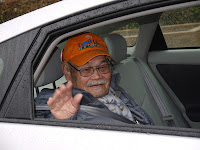BROTHERS’
THRILLING REUNION CONNECTS THE WORLD. [Installment #3] Thanks to Associated Press writer Yuri
Kageyama and photographer Shizuo Kambayashi, the team who chronicled Eskaton’s
Thrill of a Lifetime reunion of brothers Mino Ohye, 86, and Hiroshi, 84, billions
of people across the globe were able to experience their extraordinary story
vicariously.
So far, more
than 250 newspapers and radio and television stations reported on “Brothers reunited in Japan
after six decades apart.” From Japan to the United States, from Australia to India
to Kuwait, the feel-good story captured the attention of editors and readers
and viewers. And donors, too, who have asked how to contribute to the Thrill program.
“How are you
going to top this?” The refrain is music to the ears of Eskaton’s Public
Relations Department staff. Though this Thrill of a Lifetime may be a once in a
lifetime experience, the benefits continue to multiply. Among them, the resounding
validation of the adage “Success has a thousand fathers while failure is an
orphan.” The Thrill initiative’s profile around the world is higher than ever, and
now so too is support within the organization. In fact, the depth of
involvement in coordinating this successful venture has produced many proud, bumper-sticker sporting parents.
Yet, it is another
entertaining takeaway from the experience that’s taught us something more endearing:
There are two types of people in the world, those who love Mino Ohye … and
those who have not yet met him.
Ohye returns
home to Eskaton Wilson Manor in West Sacramento on Saturday, January 28. Watch for
a fourth and final installment.
 Quality is
memorable. It is held in high esteem. Low price and deadlines are fleeting. As
is the benefit of their immediate gratification.
Quality is
memorable. It is held in high esteem. Low price and deadlines are fleeting. As
is the benefit of their immediate gratification.






